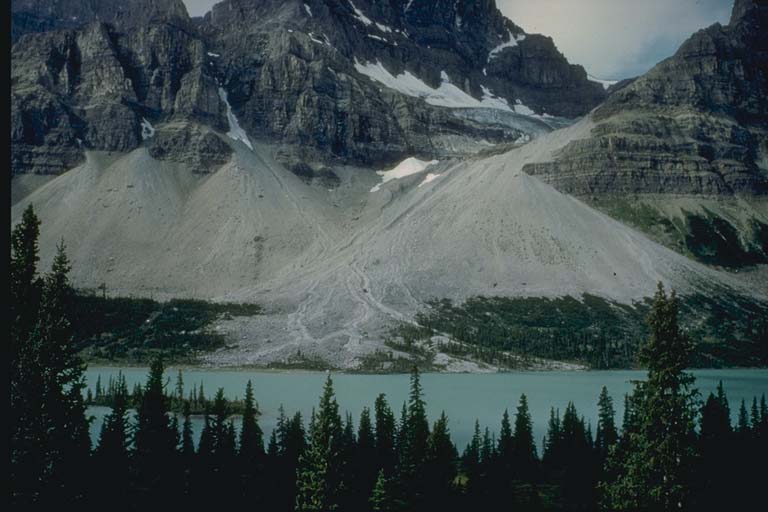Neill's Geology:
Disasters!

Home / Glaciologists / Marine Geologists / Paleontologists / Seismologists / Gemmologists
1. Landslides!

When you here the word Landslide! what do you think of? You say you think of a mass of snow, rocks, or wet mud sliding down from a high altitude triggered by a catalyst event? By golly, you're right!
Landslides occur along something called (are you ready?) a plane of structural weakness! So what, you say? Well, that means that all this muck coming down the side of the mountain, heading straight for you and your dog and your little log shack, is following the path of least resistance. The plane of structural weakness! is the term for a path, in the mountain, that is relatively free of debris and usually is between the two highest points of the mountain.
Some landslides are called mudflows, and, man, you would never want to be caught in one of those things. I mean, they are as nasty as Geology gets. They can be caused by road construction, earthquakes, a change in the way a stream or the ocean hits the land, freezing-and-thawing, or lots of rain. Picture this: it's raining. It starts raining harder. And harder. And harder. And you just so happen to be a pile of dirt sitting on top of a Colorado mountain, minding your own business. Well, pretty soon you turn into mud, and if it rains hard enough, you may very well decide to just slosh on down the mountain to see what's going on down there. Well, all the other dirt piles on your little mountain had the same idea, and you all get together and turn into a big ol' river of mud, charging down the mountain. On your way down, if your river is strong enough, you can pick up boulders that weigh as much as people and bring them along for the ride. Along the way, big cliffs of dirt can fall off the mountain into your mud river because they have gotten so heavy with water (we scientists call that saturation). Mudflows are so strong sometimes that they carry enourmous boulders down the mountain. If the mudflow is really big, it can destroy nearby towns. I'm not kidding.
Some mudflows are active for years! Isn't that amazing? It's all part of the really super cool way that Geology works: Volcanoes and converging plates push mountains up, and mudflows and rain tear them back down, bit by tiny bit, over thousands of years, until they are flat. See, without mudflows and erosion (little tiny mudflows that happen all year round), the world would be just covered in mountains! It would be like living on a really huge porcupine. Little hills and big hills and mountains would be just everywhere. But erosion and mudflows pull down the mountains, and make room for new ones. Geology is just one big cycle after another. That's what makes it so cool!
Earthflows are mudflows that aren't as wet. Pretty basic, huh? I bet you could have guessed that.
2. Avalanches!

The avalanches you are have probably seen are on TV, and involve mountain climbers on Mt. Everest, or people who have been in a plane crash in Alaska and are attempting a thrilling escape. The truth is, the most fatalities in avalanches occur in Colorado, and Coloradans are very concientious about landslide safety. Anyone worth his or her snow shoes would always be sure to check landslide conditions before he or she went out skiing or hiking in the middle of the mountains.
Some people, alas, forget to check conditions, or do silly things like skiing where they absoloutely shouldn't, or just get unlucky. This is what happens to those people who get caught in an avalanche: They're walking/ skiing/ hiking/ dancing along in the snowy wonderland of Colorado. The crust of the snow seems firm, but they keep breaking into sugar snow (fine, powdery snow underneath). They walk/ ski/ hike/ dance onto a 25-50% slope. One of them notices a small snow slide, but thinks nothing of it. All of a sudden the snow engulfs the hikers and they find themselves tumbling over and over, or sliding headfirst into a tree. Hopefully, one or all are not buried headfirst: a buried person only has about 15 minutes before they smother. The snow around someone who has become trapped melts with body heat, then refreezes to turn into totally immobile ice. If the hikers are not carrying beacons that can alert Avalanche Rescue Teams or shovels, they are in big trouble. To read a really great account of someone who has been through an avalanche and come out fairly unscathed, click here. For more information on avalanche safety, visit the Colorado Avalanche Information Center.
3. Tsunamis!

Let's just get one thing straight right off the bat. Tsunamis are
Tsunamis kill people. That's what makes them a disaster, and that's why I stuck 'em on this page!
break
break
break
break
break
break
break
break
break
Are Disasters So Cool You Just Can't Stand Them?
Well, Check These Places Out!
The Colorado Avalanche Information Center
The Cyberspace Snow and Avalanche Center
National Geophysical Data Center: Natural Disasters
Pictures Courtesy Of:
National Geophysical Data Center | The Colorado Avalanche Information Center | |

Geology Contest / Disasters! / Ask-A-Geologist / Links
About the Author / Contest Winners! / What can YOU do?
Do you have any questions, or ideas on how to make this a better site?
If so, please e-mail me here.